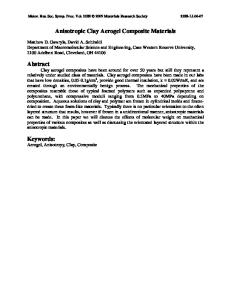Introduction to Composite Materials
This chapter gives an overview of the important aspects of composite materials. The need for composite materials and the advantages over conventional materials are discussed. The definition of composite materials is given with suitable examples. The class
- PDF / 639,259 Bytes
- 38 Pages / 439.37 x 666.142 pts Page_size
- 4 Downloads / 477 Views
Abstract This chapter gives an overview of the important aspects of composite materials. The need for composite materials and the advantages over conventional materials are discussed. The definition of composite materials is given with suitable examples. The classification of composites based on the matrix and reinforcement is explained in this chapter. The fundamental aspects like, load transfer and rule of mixtures are discussed in detail. The important characteristics of different fibres and matrices are explained briefly. Manufacturing methods for polymer, metal and ceramic matrix composites are briefly explained in this chapter. Some of the important applications of composites are also highlighted here. Materials with unusual combination of properties are required for modern technologies. Since the properties of conventional materials are limited, they cannot meet the requirements. In general, the high strength materials are heavy or brittle. The material property combinations have been extended with composite materials. It is possible to produce a composite material with high strength and light weight. Like this, materials with unusual combination of properties can be made with composite materials. For example, cemented carbide, the composite of tungsten carbide and cobalt, has very high hardness and appreciable toughness. Similarly light weight composites can be made with good electrical properties, chemical resistance or optical properties. Composite materials are a combination of two or more materials in such a way that there are certain desired properties or improved properties. The nature itself is making many composites because of their high performance. Wood and bone are the common examples of natural composites. The constituents of wood are cellulose fibre and lignin matrix, whereas in bone, soft and strong collagen surrounds hard and brittle apatite. The principle of combined action is utilised in composites to get better properties. For example, the polymer composite gets flexibility and light weight from polymer matrix and high strength from the fibre reinforcement. M. Balasubramanian (&) Department of Metallurgical & Materials Engineering, Indian Institute of Technology Madras, Chennai 600036, India e-mail: [email protected] © Springer Science+Business Media Singapore 2016 S. Rana and R. Fangueiro (eds.), Fibrous and Textile Materials for Composite Applications, Textile Science and Clothing Technology, DOI 10.1007/978-981-10-0234-2_1
1
2
M. Balasubramanian
The composite materials have many advantages over conventional materials. Most of the composites are made with light-weight materials. However, their mechanical properties are significantly high. Hence, the specific strength and modulus values of composites are very high. They have very good chemical resistance and weather resistance. There are many reinforcements and a variety of matrix materials available. By a suitable selection of reinforcement and matrix material, it is possible to get the desired properties from the final composite. When the fi
Data Loading...











